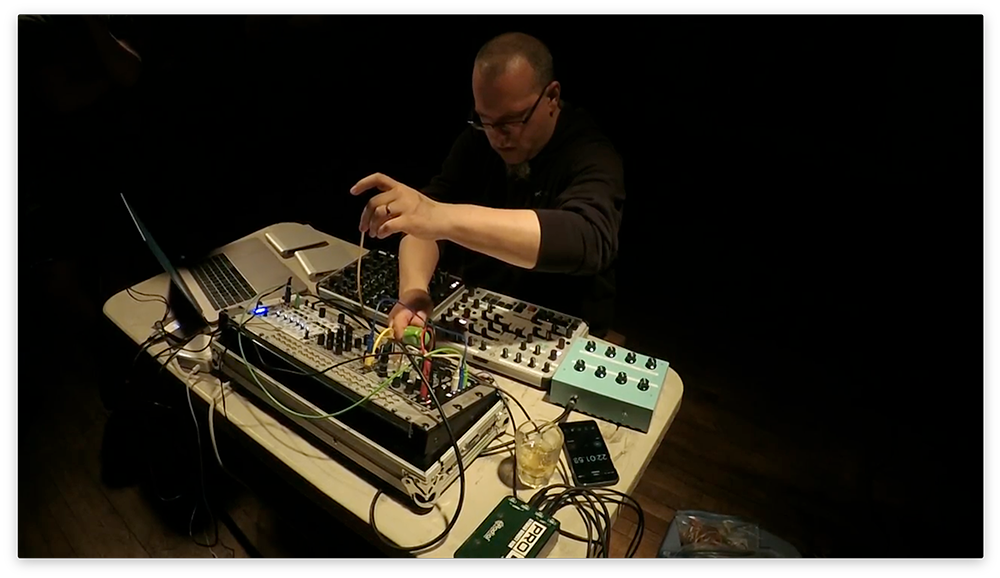Quarries (2016-22)
︎︎︎ October 23, 2022. Machines with Magnets, Pawtucket, RI
Quarries is a flexible, evolving system for electroacoustic improvisation building upon aspects of my prior systems
with refined approaches to synthesis, sampling, and audio processing. Quarries has evolved over a period of seven years, developed between performances at club venues, taking into account the discoveries made along the way. The
underlying programming language has shifted from Pure Data (Pd) to MaxMSP.
At first focused on the processing of contact mic’ed percussion instruments, the software has expanded to include its own internal synthesis engine with I/O for external effects and modular synths. For gestural control, the performer presently uses three Sensel Morph multitouch sensors and a DJ-style MIDI controller (Faderfox DJ-44), among other equipment to augment the system.
At first focused on the processing of contact mic’ed percussion instruments, the software has expanded to include its own internal synthesis engine with I/O for external effects and modular synths. For gestural control, the performer presently uses three Sensel Morph multitouch sensors and a DJ-style MIDI controller (Faderfox DJ-44), among other equipment to augment the system.
︎︎︎ January 15, 2021. Non-Event at Home
Both through chance and intention, the performer adjusts
parameters of an erratic synthesis process. Responding to the results, the player samples segments for further
manipulation, hunts for emergent patterns, provides contrast with sampled live percussion, and improvises within
the arising circumstances.
Quarries was first presented at the Pure Data Convention (PdCon) in 2016 (NYU / Stevens Institute of Technology). Following performances included several venues in Rhode Island, Anchorage Museum (2017 Alaska), Human Resources (2019 Los Angeles), and a livestream for Boston’s Non-Event Experimental and New Music Series in January 2021.
Quarries was first presented at the Pure Data Convention (PdCon) in 2016 (NYU / Stevens Institute of Technology). Following performances included several venues in Rhode Island, Anchorage Museum (2017 Alaska), Human Resources (2019 Los Angeles), and a livestream for Boston’s Non-Event Experimental and New Music Series in January 2021.
︎︎︎ March 30, 2018. Machines wiht Magnets, Pawtucket, RI
︎︎︎ May 6, 2017. AS220, Providence, RI
︎︎︎ July 22, 2016. Machines with Magnets, Pawtucket, RI
︎︎︎ May 6, 2017. AS220, Providence, RI
︎︎︎ July 22, 2016. Machines with Magnets, Pawtucket, RI






︎︎︎ Quarries in performance
Quarries HSL (2016-18)
Quarries HSL is an improvisational performance approaching high density loudspeaker arrays as new interfaces for musical expression. Central to the piece is the use of visual image data scanned from works on paper using a live camera, applied as spatial audio positions and movements. For example, color data is applied as ambisonic coordinates with hue = azimuth, saturation = distance, and lightness = elevation. The works on paper from which the scans are taken function as a catalog of possibilities to be explored during performance. The performer refines the sonic experience through image processing, including adjustments to scan rate, zoom, hue shift, brightness, contrast, and saturation. Using multitouch sensors and a MIDI controller, the performer also creates the sounds spatialized by the camera scanning process. These interfaces provide access to parameters for sound synthesis and transformations of field recordings.
The piece builds upon my previous investigations in graphic sound synthesis, and was developed between 2015-2017 at Virginia Tech’s Cube, University of Birmingham’s BEAST, and RPI’s EMPAC. It has been configured for as many as 140 channels. As the title suggests, this work is a variation on my Quarries system detailed above.
This workwas performed at the International Conference on New Interfaces for Musical Expression (2018 Virginia Tech, Blacksburg) and the International Computer Music Conference (2018, Daegu). It was also performed at the BEAST FEaST (2017, Birmingham UK) and Cube Fest (2016 Virginia Tech, Blacksburg).
︎︎︎ Quarries HSL demonstration
︎︎︎ Quarries HSL sound check at VT Cube






